Portunus pelagicus (Linnaeus, 1758)Blue Swimming Crab

Figure 1: Live adult specimen of the blue swimming crab (male) [26].
Table of Contents
1. Introduction
The blue swimming crab is a large commercially valuable crab found within tropical and subtropical regions of the Indo-West Pacific. There are over 80 species under the genus Portunus worldwide [1]. First described by Carl Linnaeus in 1758, it was first named Cancer pelagicus but later transferred to a different genus, Portunus. As implied from its name, the blue swimming crab is an excellent swimmer, mainly due to the modification of its last pair of walking legs. And if you are Singaporean or a fan of the local cuisine, this is the crab that is most commonly used in the Singapore chili crab and pepper crab dish!2. Common Names
Flower crab, blue crab, blue swimmer crab, blue manna crab, sand crab, alimasag (Tagalog), etc.3. Physical Appearance
The carapace width of the flower crab can grow up to about 20 cm, the width being 2.2 to 2.3 times wider than the length. The carapace is covered in fine granules with 9 white-tipped spines on the antero-lateral margin, that increase in size from the eyes outwards. The spines are small but conspicuous. It has 5 pairs of walking legs. The first pair has been modified into a long, slender cheliped (the merus, carpus, manus and dactylus combined), with 3 sharp spines on the inner margins of the merus. The second, third and fourth walking legs are slender and elongated. The last pair of walking legs, the 5th pair, is oval and paddle-shaped at the end and rotates easily to aid in swimming in all directions [2, 3].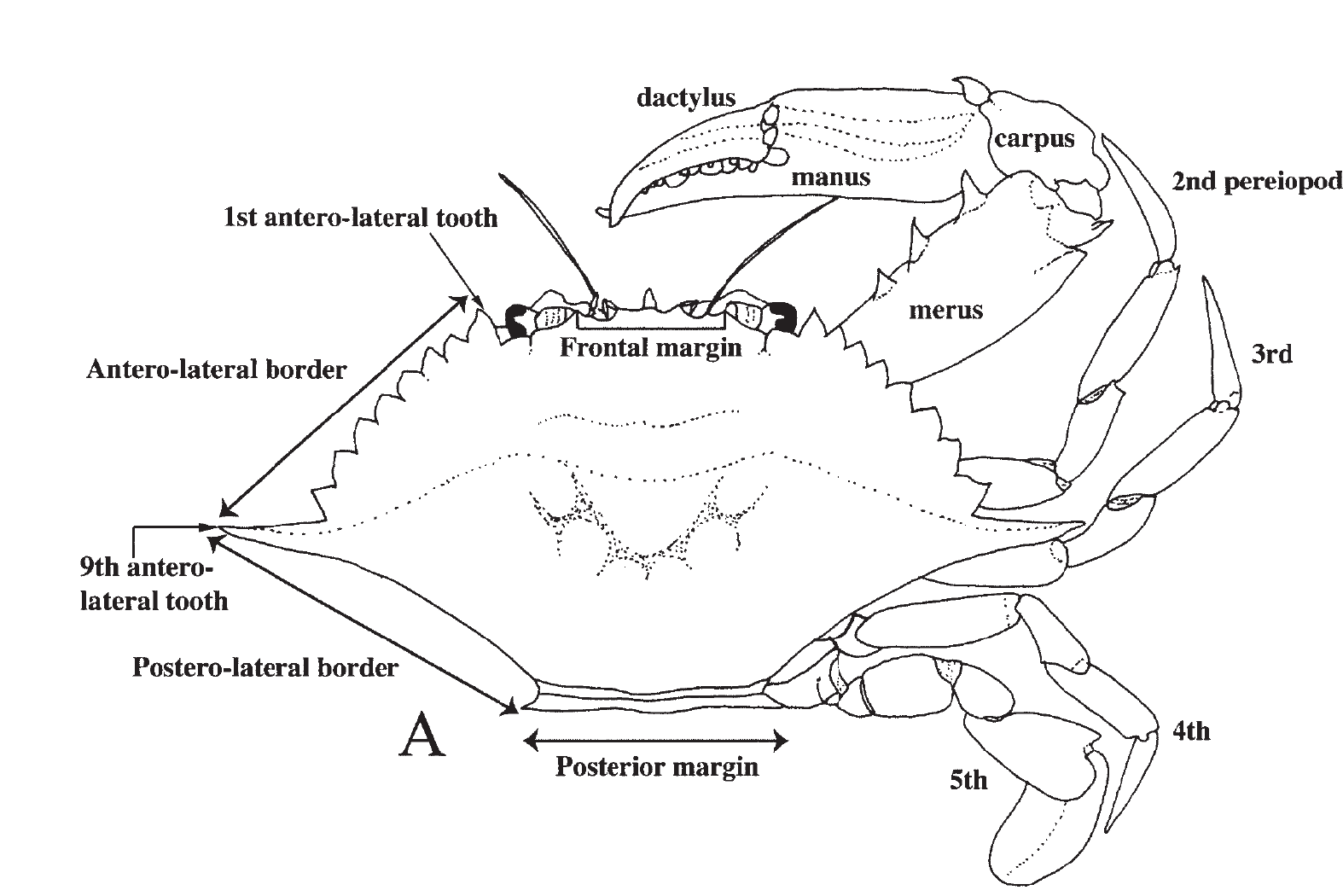
3.1 Sexual Dimorphism
Although the Portunus pelagicus is called the blue swimming crab, the species exhibits sexual dimorphism. The females are better camouflaged in uniform dull green-brown carapace with red-tipped chelipeds, while the males possess a dark blue-green carapace with purple-blue chelipeds with red tips (Figure 3). However, both sexes possess white spots on their carapace and chelipeds, commonly joining to form broad, almost banded reticulations [2]. The abdomens of both sexes also differ as seen in Figure 5. The male abdomen is narrow, pointed and triangular, resembling an inverted 'T'. On the other hand, the female abdomen is broad and oval-shaped for carrying eggs during breeding [4].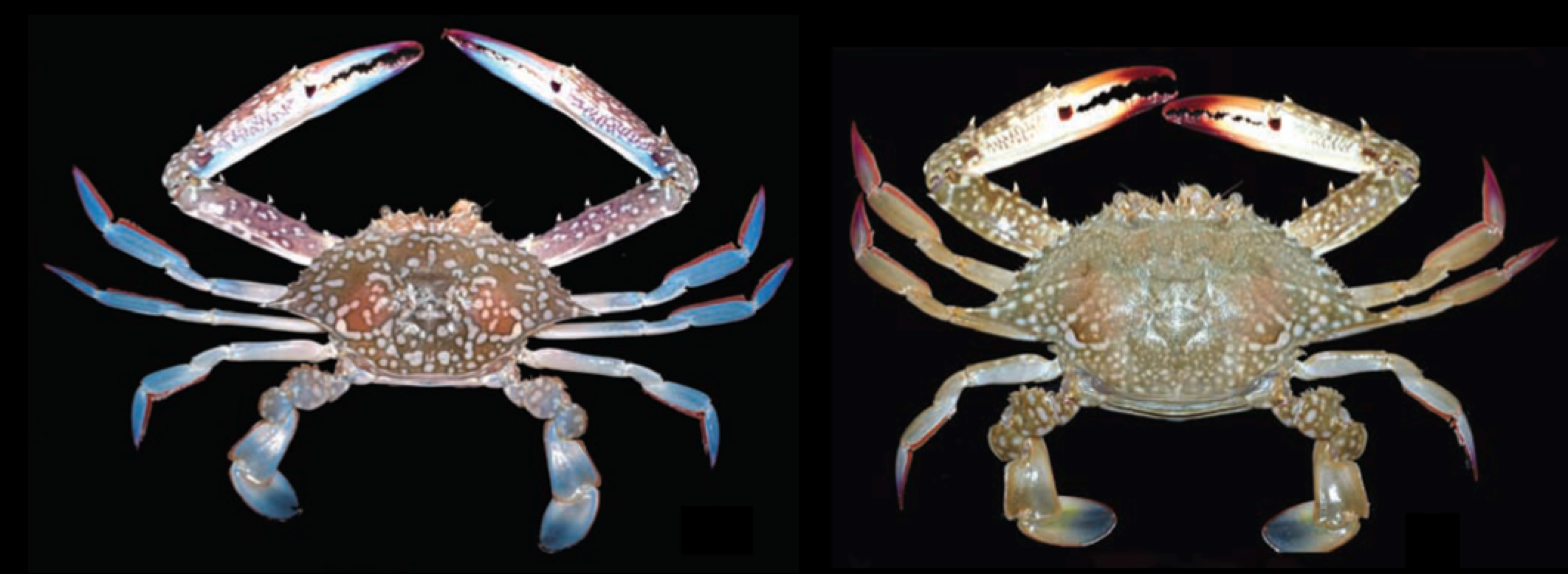
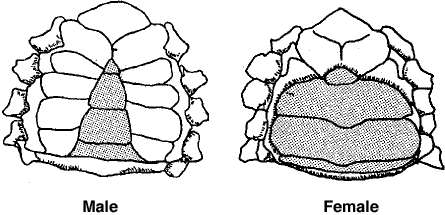
Figure 4: Diagram showing the difference in male and female abdomen shape of Portunus pelagicus [27].
4. Distribution & Habitat
The blue swimming crab is found widespread across the coastal waters of the Indo-West Pacific, from as far north as Japan, the Red Sea, Mediterranean Sea, around Southeast Asia, and as far south as Northern Territory in Australia and East Africa (Figure 5) [2,5].
It is normally found in habitats with sandy or muddy bottoms of shallow coastal waters, between depths of 10 to 50 m, including habitats such as rocky shores, in reefs, mangroves, seagrass and algal beds [6].
In Singapore, the blue swimming crab around many of the shores, especially areas with seagrasses and seaweed, and along the northern shores [7].
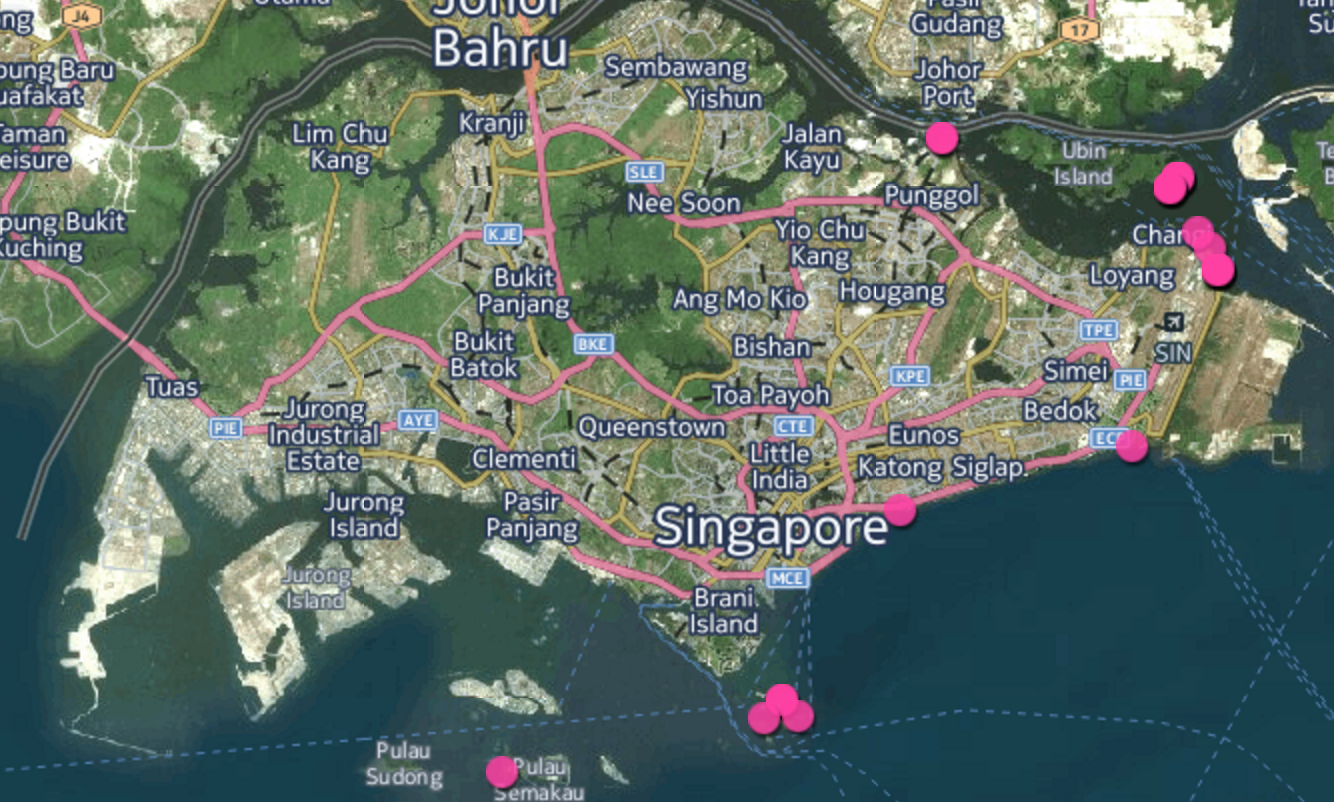
5. Feeding
The blue swimming crab is normally found buried under sand or mud, coming out to feed during dusk [8]. The crab chops its food into small pieces with its mouthparts and then grinds its down further with the help of its gastric mill ossicles located in the foregut [4].This almost exclusively carnivorous crab feeds on a broad array from slow-moving and sessile invertebrates (i.e. gastropods, bivalves, hermit crabs and ophiurods) to teleost fish, other crustaceans and organic matter (i.e. marine plants and seagrasses). This species is said to be an opportunistic predator, it diet depending on the availability of its prey in its environment [4, 9, 10]. Cannibalism is also exhibited.
Studies have also shown thats the diet composition of the blue swimming crab changes to a certain extent with the size of the crab. During its planktonic free-swimming phase, the larvae feed on phytoplankton and zooplankton in the water column [11]. As the crab develops into a juvenile and undergoes moulting frequently in different stages during growth, a diet high in calcium is required for shell formation. Thus, favouring a diet composing mostly of crustaceans, fish bone and shelled molluscs.
In another study conducted in western Australia, it was noted that although the male and female crabs had the same diet, they consumed different quantities of food with the female eating more. This suggests that the female crab requires more energy during ovogenesis [11].
Video 1: Portunus pelagicus feeding [30].
6. Reproduction
The blue swimming crab breeds all year round [12]. Like most marine crabs, this species uses kairomones to attract a mate. Mating usually begins shortly after the female has moulted and is still soft. The male and female are attached abdomen-to-abdomen, as the male crab turns the female crab upside down. The female crab opens her hinged abdomen, uncovering her gonopores allowing the male crab to insert his gonopod to transfer spermatophores into the female. The spermatophores (packets of sperm) are stored within the female to be utilized during fertilzation once her ovaries have produced viable oocytes (egg cells) [13].Once the female crab is ready to spawn, oocytes are released form the ovaries after fertilization has occurred and extruded into a cohesive mass that continues to remain attached to the female crab's abdomen via fine hairs. Hatching occurs once the female crab releases the planktonic larvae to drift up and down the water column [13].
Video 2: Mating of Portunus pelagicus [31].
7. Life Cycle
The life cycle of most crabs from an egg into a mature adult is via zoea. As a crustacean, the blue swimming crab possesses a hard exoskeleton that must be shed, via moulting or ecdysis, at intervals in order to grow [14]. This species undergoes four zoea stages and a megalopa stage before moulting to a crab instar, where it then begins to resemble an adult crab (seen in Figure 7) [4]. It has 16 crab instar stages (Figure 8).The first two zoeal stages last about 3 to 4 days each, the 3rd and 4th zoeal stage about 2 to 3 days each, the megalopa stage about 3 to 5 days, then reach the first crab instar in 15 to 17 days [15]. The male crab is able to reach sexual maturity by its 12th moult while the female at its 14th moult [14].
The quantity and quality of food available and temperature of the surrounding water are the two most important environmental factors that affect the growth and moulting in crabs and other crustaceans [14]. Immediately after moulting, when the new carapace is still soft and hardening, this is when the crab is most vulnerable to predation and must remain hidden. Studies have also shown that lost limbs can be regenerated by moulting. However, if the appendage is lost multiple times, the interval between moults and growth during each subsequent moult will be severely affected [16, 17].
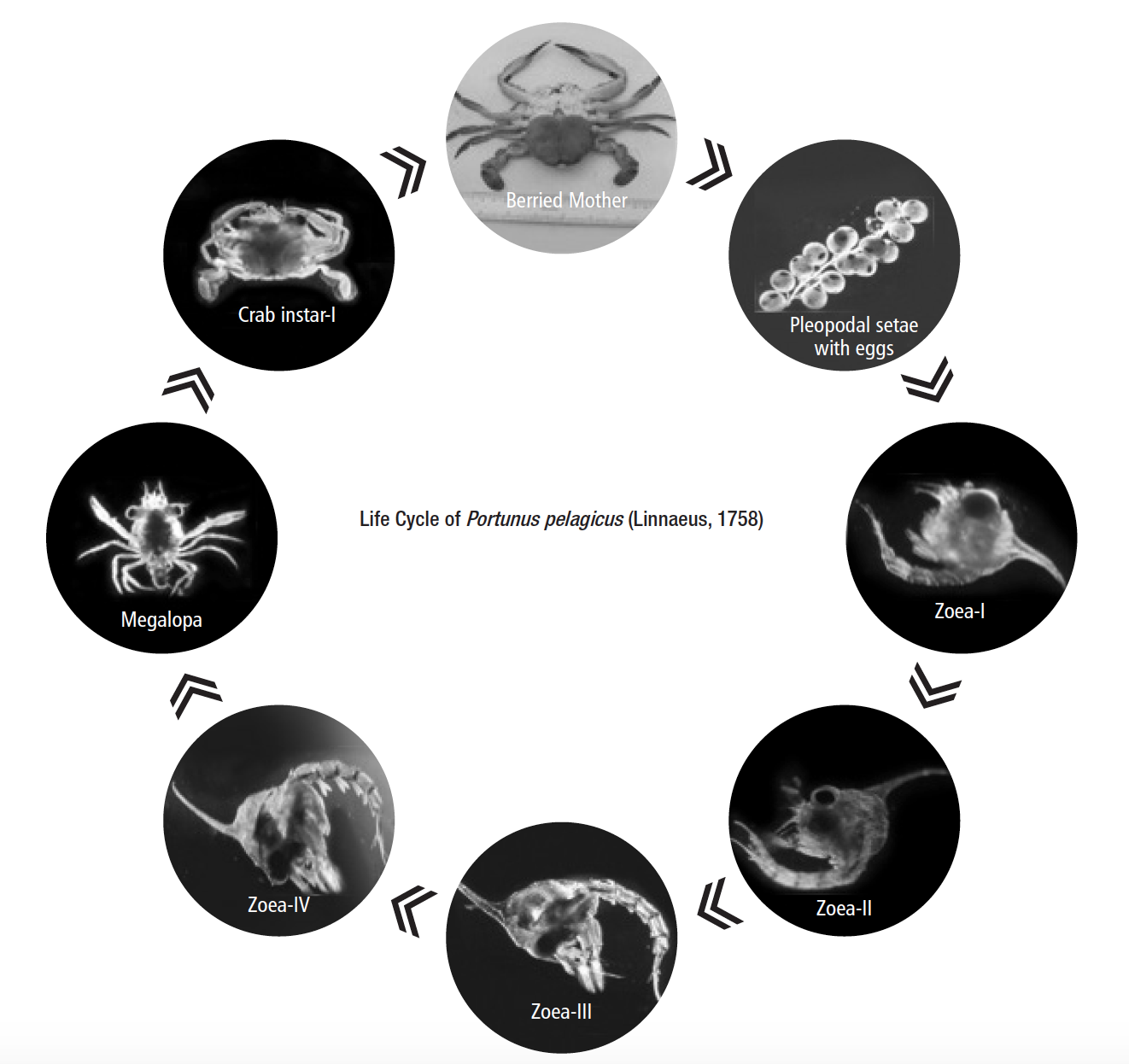
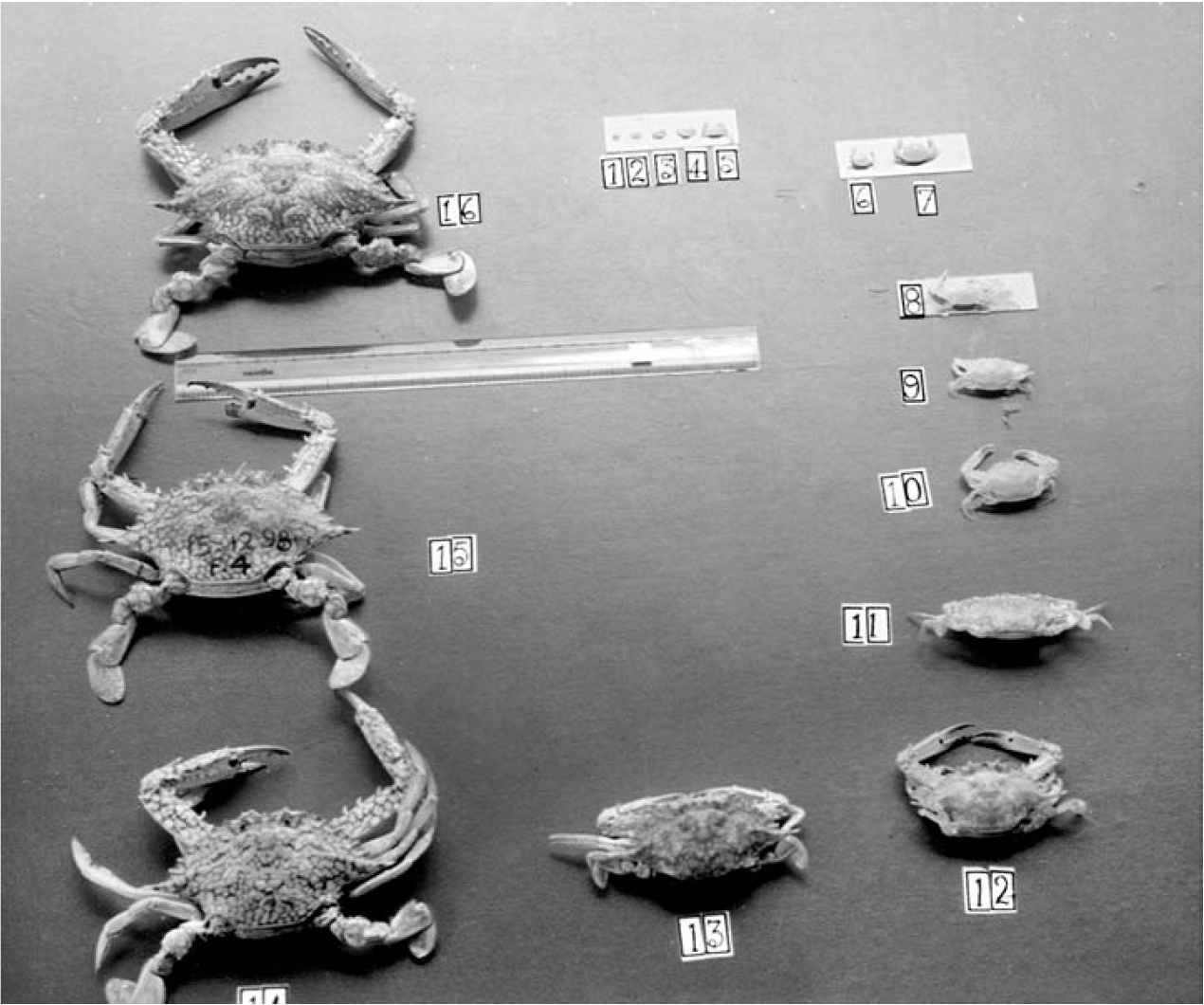
Video 3: Life cycle of the Blue Crab [32].
8. Economic Value
The blue swimming crab is one of the most commercially prized species, representing a valuable portion of small-scale coastal fisheries in numerous countries in the tropics [5]. This species is sold fresh or frozen in the market but also extensively used in the crab-flesh canning industry [18]. It is mainly collected by trawls, beach seines, artisinal traps, gill nets and other different kinds of traps. The demand of demand for this species has been increasing rapidly over the decades (Figure 9) [19].As global capture slowly stagnated and the demand for the blue swimming crab still rising, producers looked to aquaculture to close the gap. The high fecundity, fast growth, high tolerance for nitrate and ammonia, and ease of larviculture, has made this it ideal for aquaculture [6]. The growth in global aquaculture production can be seen in Figure 10. The decline in wild stock due to overexploitation of the blue swimming crab has prompted numerous research projects to better understand the reproduction process, growth and factors affecting the species so as to raise the effectiveness of production in aquaculture [20].

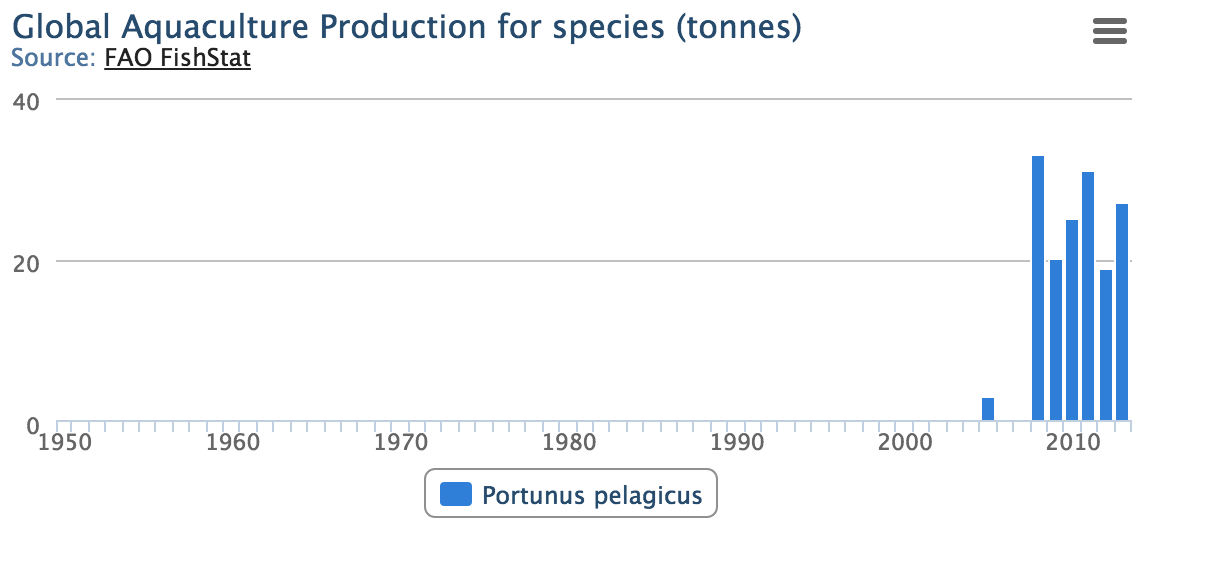
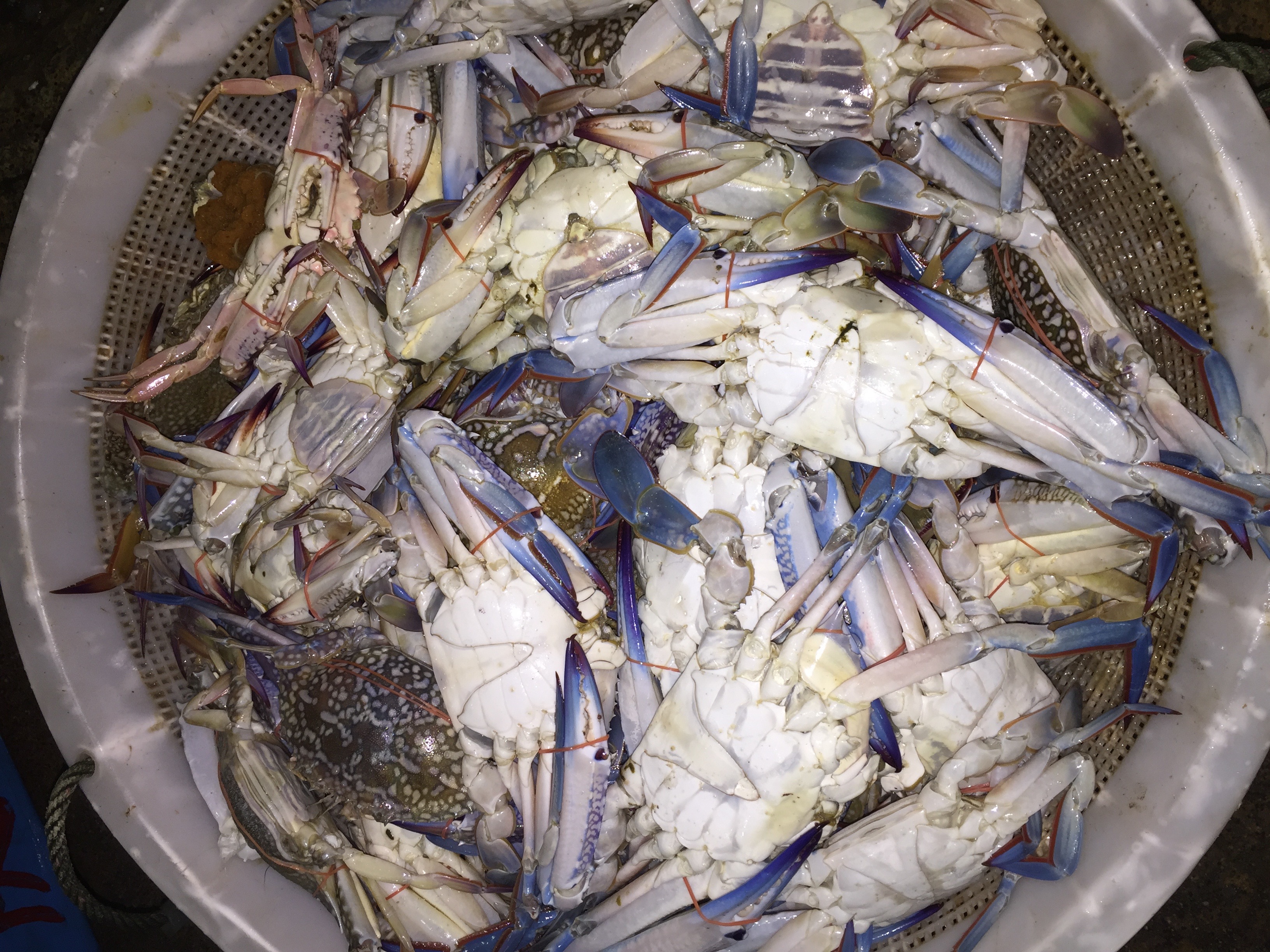
9. Conservation Status
Portunus pelagicus has not been assessed for the IUCN Red List and is considered "extant" [21]. In addition, due to its widespread distribution and production in aquaculture it currently does not face the threat of extinction.10. Taxonomy & Systematics
10.1 Taxonomic Hierarchy
| Kingdom |
Animalia |
| Phylum |
Arthropoda |
| Subphylum |
Crustacea |
| Class |
Malacostraca |
| Order |
Decapoda |
| Infraorder |
Brachyura |
| Family |
Portunidae |
| Genus |
Portunus |
| Species |
Portunus pelagicus |
10.2 Synonyms
Portunus cedonulli, Portunus denticulatas and Portunus pelagicus var. sinensis [2].10.3 Original Description
The original description by Linnaeus (1758 : 626) of Cancer pelagicus:"[Cancer] pelagicus. 11. C[ancer]. brachyurus, thorace laevi untrinque unispinoso fronte octo-
dentatata, manibus multangulo-prismaticis.
Osb. iter. 307. C. manuum articulis omnibus dentatis & extimo heptagono.
Rumph. mus. t. 7. f. R. Brown, jam. 421. t. 41. f. 2
Habitat in Pelagi universi orbis Fuco natante."
(Figure 12)
The original description by Carl Linnaeus of Cancer pelagicus (known today as Portunus pelagicus) was under Class Insecta, Order Aptera and Genera Cancer (i.e. crabs, lobsters and kin). Linnaeus use the specimens collected by Osbeck from the Sargasso Sea (1752), a specimen caught by Rumohius in Ambon, Indonesia (1705) and a specimen caught by Browne (1756) to describe Cancer pelagicus [23]. The description is very short and vague, thus not very helpful. In addition, no specific locality or geographical location was identified for the distribution of this species.
Figure 12: Original description of Portunus (Cancer) pelagicus by Linnaeus (1758) in Systema Naturae [35].
10.4 Lectotype
No type specimen was designated by Linnaeus. As mentioned earlier, the species was described using 3 specimens. However, the specimens captured by Osbeck and Browne were later renamed as different species, Portunus sayi and Lupella forceps, respectively. The specimen caught by Rumphius was unanimously chosen by later authors as Linnaeus's Cancer pelagicus and it was only until 2004 when Holthius officially named that specimen the lectotype of Cancer pelagicus [23].10.5 Phylogeny
Despite the high ecological and economic value of the genus, there are numerous inconsistent and subtle differences in the diagnoses of morphology of the adult swimming crabs. A study published in 2007 on the molecular phylogeny of the genus Portunus using partial fragments of the 16S rRNA gene was conducted to better understand the relationship among the species of the genus [24]. Mitochondrial DNA (mtDNA) was chosen for its suitable characteristics (i.e. subject to high mutation rate, maternally inherited, easy to isolate and abundant) and is commonly used in phylogenetic studies in decapods [25, 26].From the analyses, the genus Portunus was divided into at least 3 clades (clade A, B and C as shown in Figure 13). Portunus pelagicus, located in Clade A is shown to be well separated from the other 2 clades.
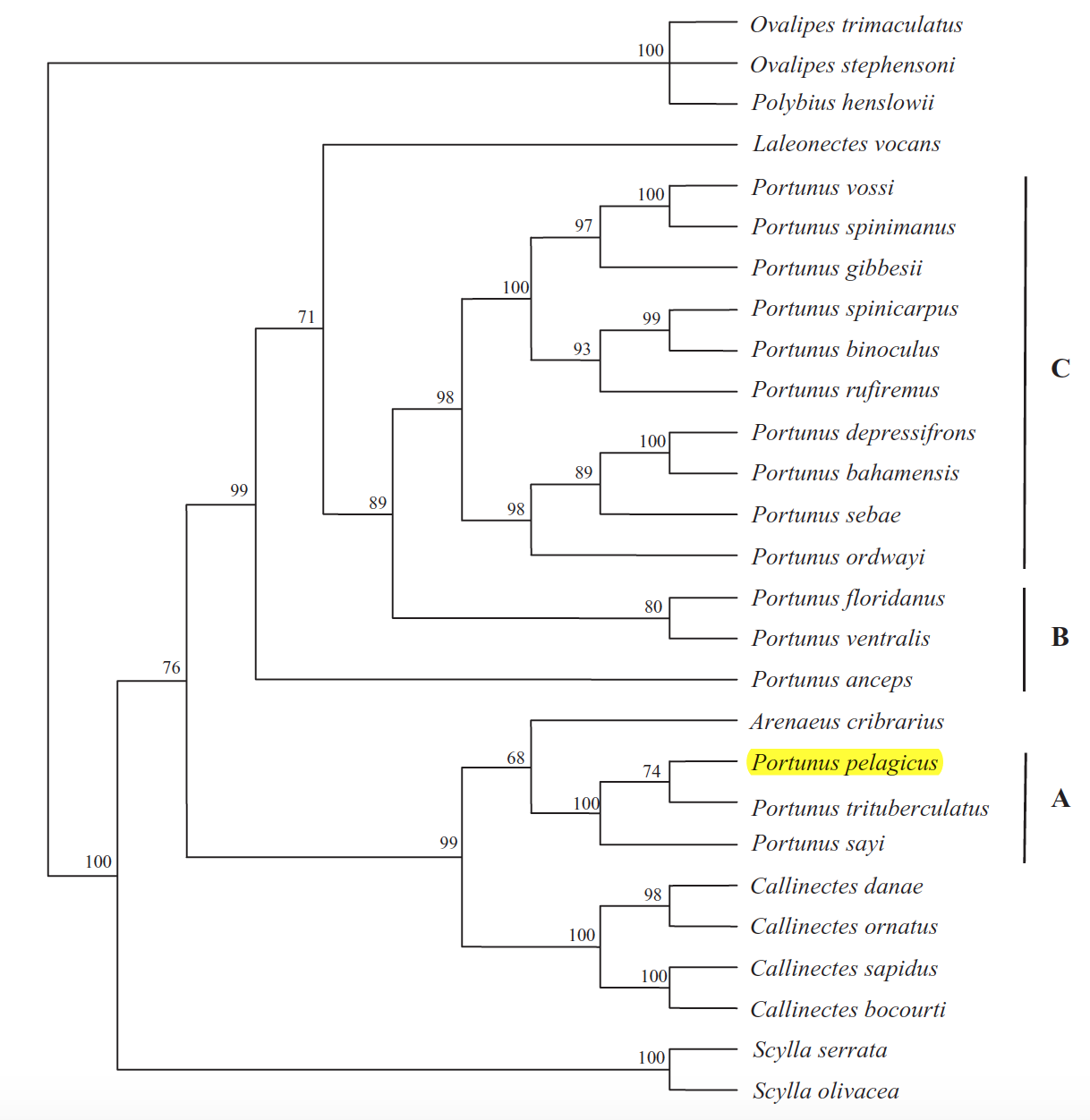
Figure 13: Consensus phylogenetic tree of 16S rRNA gene sequences by Mantellato et al. (2007). Numbers on the on the tree are posterior probabilities. A, B and C are the 3 major clades. Obtained and accredited under fair use.
A more recent phylogenetic study on the Portunus pelagicus species complex, this time using COI gene, yielded genetic data that separated the four species into 2 related sister groups; P. pelagicus and P. segnis to P. armatus and P. reticulatus, with an average genetic difference of ~7% between the 2 sister groups [2].
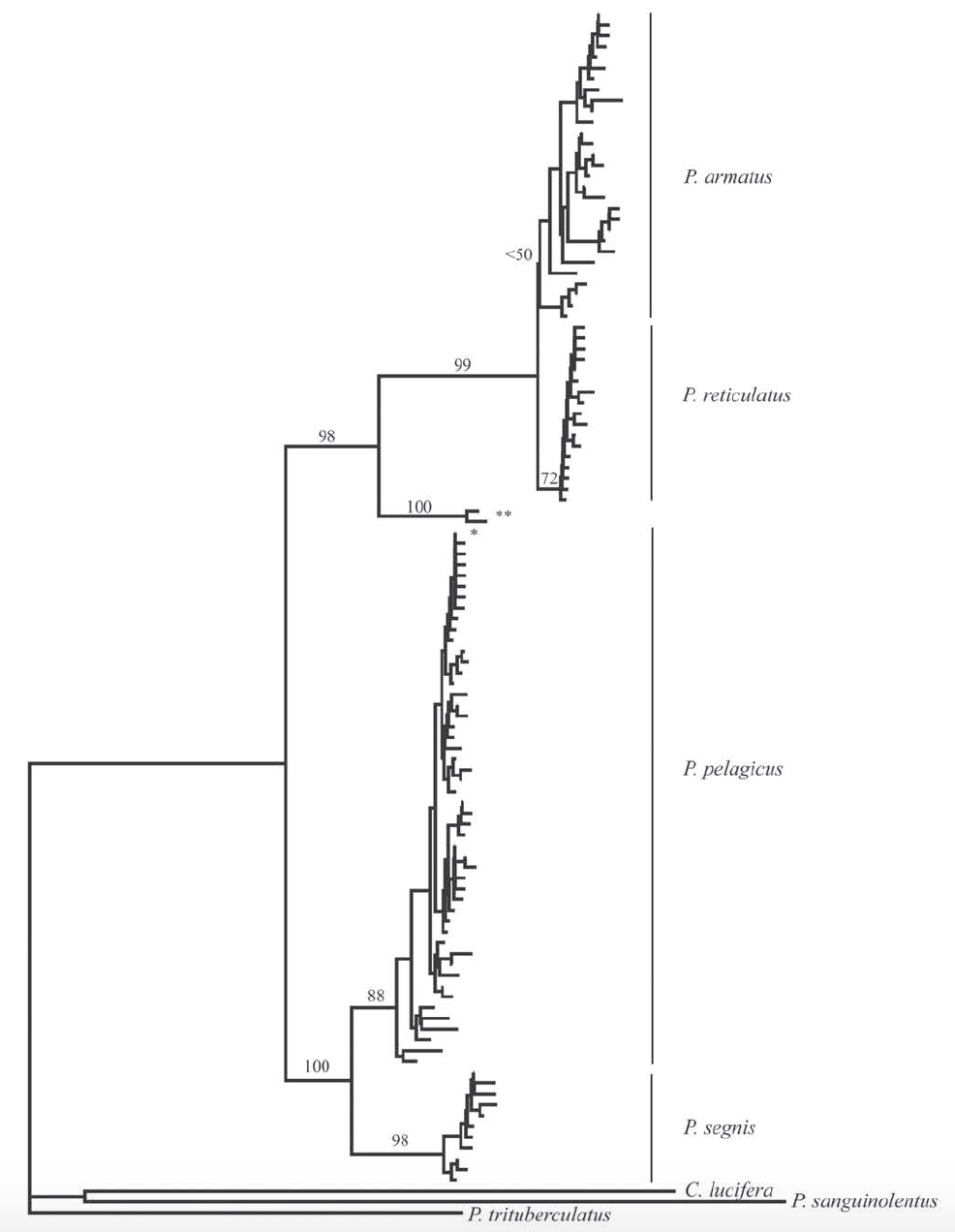
by Lai et al. (2010). Obtained and accredited under fair use.
10.6 DNA Barcoding
The entire genome of the blue swimming crab has yet to be sequenced, however, the National Center for Biotechnology Information has barcode sequences for nucleotide and protein encoding genes which can be found here.11. Glossary
(Table of Contents)Bivalves: an aquatic mollusc which has a compressed body enclosed within a hinged or unhinged shell, such as oysters, mussels, clams, and scallops.
Carapace: the hard upper shell of a crustacean, tortoise or arachnid.
Cheliped: In the context of the flower, the cheliped is the appendage with the claw. In decapod crustaceans, the cheliped is the appendage that bears the large chelae.
Decapod: an order of crustaceans including shrimps, crabs, lobsters, crayfish, prawns, etc.
Fecundity: the ability to produce abundant healthy growth or offspring.
Ecdysis: the moulting of the cuticle in many invertebrates.
Exoskeleton: a rigid external covering for the body in some invertebrate animals, especially arthropods.
Gastric Mill Ossicles: a food grinding apparatus in the foregut of decapod crustaceans.
Gastropod: a class under the phylum Mollusca, more commonly known as snails, slugs or whelks.
Gonopod: an appendage in many arthropods modified to serve as a copulatory organ.
Gonopore: genital pores of a female decapod.
Haplotype: a set of genetic determinants located on a single chromosome.
Instar: a developmental stage of arthropods (i.e. crabs) between each moult until sexual maturity is reached.
Kairomones: a chemical substance emitted by an organism that can detected by another individual.
Lectotype: a specimen chosen as the type of a species or subspecies if the author of the name fails to designate a type.
Megalopa: post-larval stage.
Ophiurods: commonly known as brittle stars
Ovogenesis: the creation of an ovum (egg cell).
Reticulation: a pattern or arrangement of interlacing lines resembling a net.
Sexual dimorphism: Distinct difference in size or appearance between sexes of a species in addition to the sexual organs themselves.
Spermatophores: a protein capsule containing a mass of spermatozoa, transferred during mating in various insects, arthropods, cephalopod, molluscs, etc.
Teleost fish: one of the three infraclasses in class Actinopterygii, the ray-finned fishes.
Zoea: a free-swimming planktonic larval form of many decapod crustaceans, and especially crabs that has a relatively large cephalothorax, conspicuous eyes, and fringed antennae and mouthparts.
12. References
1. Stephenson, W. (1972). An annotated check list and key to the Indo-West-Pacific swimming crabs (Crustacea: Decapoda: Portunidae). Royal Society of New Zealand, 1: 3-63.2. Lai, J. C. Y., P. K. L. Ng & P. J. F. Davie. (2010). A revision of the Portununs pelagicus (Linnaeus, 1758) species complex (Crustacea: Brachyura: Portunidae), with the recognition of four species. Raffles Bulletin of Zoology, 58(2): 199-237.
3. Shinkarenko, L. (1979). Development of the larval stages of the blue swimming crab Potunus pelagicus L. (Portunidae: Decapoda: Crustacea). Australian Journal of Marine and Freshwater Research, 30(4): 485-503.
4. Josileen, J. (2015). Life cycle and biology of portunid crabs.
5. Chande, A. I, & Y. D. Mgaya. (2003). The fishery of Portunus pelagicus and species diversity of portunid crabs along the coast of Dar es Salaam, Tanzania. Western Indian Ocean Journal of Marine Science, 2(1): 75-84.
6. Afsal, V. V., S. P. Antony, V. N. Sanjeevan, P. R. A. Kumar, I. S. B. Singh & R. Philip. (2012). A new isoform of anti-lipopolysaccharide factor identified from the blue swimmwr crab, Portunus pelagicus: molecular characteristics and phylogeny. Aquaculture, 356: 119-122.
7. Chou, L. M. (1998). A guide to the Coral Reef Life of Singapore. Singapore: Singapore Science Centre. 128 pages.
8. Tan, L. W. H. & P. K. L. Ng. (1988). Seashore Life in Singapore. Singapore: Singapore Science Centre.
9. Food and Agriculture Organization of the United Nations. (n.d). Portunus pelagicus species page. Retrieved November 6, 2015, from http://www.fao.org/fishery/species/2629/en.
10. Kunsook, C., N. Gajaseni & N. Paphavasit. (2014). The feeding ecology of the blue swimming crab, Portunus pelagicus (Linnaeus, 1758), at Kung Krabaen Bay, Chanthaburi Province, Thailand. Tropical Life Science Research, 25(1): 13-27.
11. Williams, M. J. (1982). Natural food and feeding in the commercial sand crab Portunus pelagicus Linnaeus, 1766 (Crustacea: Decapoda: Portunidae) in Moreton Bay, Queensland. Journal of Experimental Marine Biology and Ecology, 59(2-3): 165-176.
12. Pillai, K. & N, B, Nair. (1973). Observations ont he breeding biology of some crabs from the south-west coast of India. Journal of the Marine Biological Association of India, 15: 745-770.
13. Weis, J. S. (2012). Walking Sideways: The Remarkable World of Crabs. Ithaca, NY: Cornell University Press.
14. Josileen, J. & N. G. Menon. (2005). Growth of the blue swimmer crab, Portunus pelagicus (Linnaeus, 1758) (Decapoda, Brachyura) in captivity. Crustaceana, 78(1): 1-18.
15. Josileen, J. & N. G. Menon. (2004). Larval stages of the blue swimmer crab, Portunus pelagicus (Linnaeus, 1758) (Decapoda, Brachyura) in captivity. Crustaceana, 77(7): 785-803.
16. Bennet, D. B. (1973). The effect of limb loss and regeneration on growth of the edible crab, Cancer pagurus Linnaeus, 1758. Journal of Experimental Marine Biology and Ecology, 13: 45-53.
17. Kuris, A. M. & M. Mager. (1975). Effect of limb regeneration on size increase at molt of the shore crabs Hemigrapsus oregonensis Dana, 1851, and Pachygrapsus crassipes Randall, 1839. Journal of Experimental Zoology, 193: 105-112.
18. Svane, I. & G. Hooper. (2004). Blue swimmer crab (Portunus Pelagicus) fishery. Report from Primary Industries and Resources South Australia. Retrieved November 6, 2015, from http://pir.sa.gov.au/__data/assets/pdf_file?0016/231523/rd03_02742_2.pdf.
19. Zairion, Y. W., M. Boer &A. Fahrudin. (2015). Reproductive biology of the blue swimming crab Portunus pelagicus (Brachyura: Portunidae) in east Lampung waters, Indonesia: fecundity and reproductive potential. Tropical Life Sciences Research, 26(1): 67-85.
20. Ravi, R. & N. K. Sanil. (2013). Ovarian maturation and oogenesis in the blue swimmer crab, Portunus pelagicus (Decapoda: Portunidae). Acta Zoologica, 94: 291-299.
21."The IUCN Red List of Threatened Species" by the International Union for Conservation of Nature. IUCN, 2015. URL: www.iucnredlist.org/ (Accessed on November 22, 2015).
22. Integrated Taxonomic Information System. (2015). Portunus pelagicus (Linnaeus, 1758). Integrated Taxonomic Information System. URL: http://www.itis.gov/servlet/SingleRpt/SingleRpt (Accessed November 6, 2015).
23. Holthius, L. B. (2004). The identity and lectotype of Portunus pelagicus (L., 1758). Crustaceana, 77(10): 1267-1269.
24. Mantellato, F. L., R. Robles & D. L. Felder. (2007). Molecular phylogeny of the western Atlantic species of the genus Portunus (Crustacea, Brachyura, Portunidae). Zoological Journal of the Linnean Society, 150: 211-220.
25. Ladukakis, R. A. & A. Zouros. (2003). Animal mitochondrial DNA recombination revisited. Trends in Ecology and Evolution, 18(8): 411-417.
26. Morrison, C. L., R. Rios & J. E. Duffy. (2004). Phylogentic evidence for an ancient rapid radiation of Caribbean sponge-dwelling snapping shrimps (Synalpheus). Molecular Phylogenetics and Evolution, 30: 563-581.
26. "Flower crab (Portunus pelagicus)" by Ria Tan. Flickr, August 16, 2007.
URL: https://www.flickr.com/photos/wildsingapore/8255823691/in/photolist-dtrLeZ-838haA-dtrL2t-ztUi9H-7jZsBE-dzxgD2-dzCKXQ-a6qvnY-fG5fvr-dzCS7N-dzxnR8-dzxfKM-xEYFiF-tFpR91-dzCK1q-DNGyV-dzCK67-zwcvuo-qveJGa-qMwizi-riYVTE-vwxf3B-uyje7U-6J6dp3-bkeMcw-yRUU4t-zwh9Ki-zwcyEb-zLtVhA-zLtUrs-zwh8bg-zLtVHf-zPGBCt-zPGAUK-582EXx-zMEWaL-foyDx1-e49bsC-oZR2Pw-9MxQRx-6EXZxw-6CZrJ4-scQKsb-6EXZxo-5MiS1f-pNzabj-5G4rCD-upfwdd-pde22H-752ohm/ (Accessed November 10, 2015).
27. Diagram of the abdomen of the male and female Portunus pelagicus by Sea-Ex Australia. Permission pending.
URL: http://www.sea-ex.com/fishphotos/crab,.htm (accessed November 7, 2015).
28. Aquatic Species Distribution map of Portunus Pelagicus by Food and Agriculture Organization of the United Nations, n.d.
URL: http://www.fao.org/fishery/species/2629/en (accessed November 7, 2015).
29. Wild Singapore Flickr map of Portunus pelagicus by Ria Tan.
URL: https://www.flickr.com/photos/wildsingapore/tags/Portunus%2520pelagicus/map&fLat=1.2622&fLon=103.8661&zl=11&order_by=recent (Accessed November 22, 2015).
30. "Blue swimmer crab-Cannibalistic behavior" by Ram Moorthy. Ram Moorthy Youtube channel, June 28, 2013.
URL: https://www.youtube.com/watch?v=nXd6734bL1Q (Accessed November 22, 2015)
31. " Portunus pelagicus (Mating)" by CAT MOK. CAT MOK Youtube channel, August 29, 2014.
URL: https://www.youtube.com/watch?v=X46Ctv8PeYk (accessed November 10, 2015).
32. "Blue Crab LifeCycle" by Amy Sauls. Amy Sauls Youtube Channel, August 17, 2013.
URL: https://www.youtube.com/watch?v=tv_THgwIuxM (Accessed November 22, 2015).
33. Global capture production graph by Food and Agriculture Organization of the United Nations, n.d.
URL: http://www.fao.org/fishery/species/2629/en (accessed November 7, 2015).
34. Global aquaculture for species graph by Food and Agriculture Organization of the United Nations, n.d.
URL: http://www.fao.org/fishery/species/2629/en (accessed November 7, 2015).
35.Original description of Cancer Pelagicus by Biodiversity Heritage Library, n.d.
URL: http://www.biodiversitylibrary.org/item/10277#page/648/mode/1up (accessed November 7, 2015).
